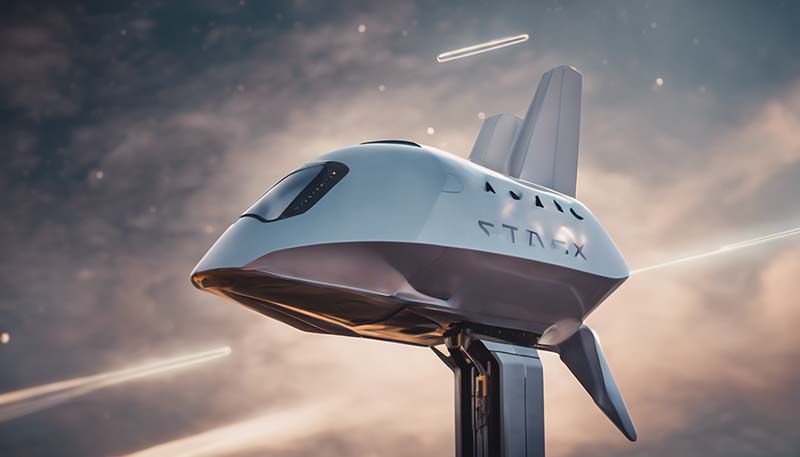SpaceX,founded in 2002 by Elon Musk,has been at the forefront of space exploration and transportation for nearly two decades.With its ambitious goals and innovative technologies,SpaceX has managed to capture the world's attention and reshape the future of space travel.One of its most significant projects is the development of the Starship – a fully reusable spacecraft designed to revolutionize space transportation and exploration.In this article,we will delve into the details of Starship,its design,capabilities,and the potential impact it could have on the future of humanity.
Overview of Starship
The Starship,previously known as the BFR (Big Falcon Rocket),is a next-generation spacecraft that aims to replace all of SpaceX's current rockets,including the Falcon 9 and Falcon Heavy.The Starship is designed to be a highly versatile and fully reusable vehicle capable of carrying both crew and cargo to a variety of destinations,including Earth orbit,the Moon,Mars,and beyond.The spacecraft consists of two main components: the Starship spacecraft and the Super Heavy rocket booster.
Design and Architecture
The Starship is built using a combination of stainless steel and carbon-fiber composite materials,which provide a high level of durability and thermal protection.The spacecraft's unique design features a sleek,aerodynamic shape,with a diameter of 9 meters (30 feet) and a height of 50 meters (164 feet) for the full stack (Starship spacecraft and Super Heavy booster).The spacecraft is also equipped with a thermal protection system to endure the extreme heat generated during re-entry into Earth's atmosphere or other celestial bodies.
The Super Heavy rocket booster is designed to be the most powerful rocket in history,with a total lift-off thrust of approximately 7,500 metric tons.The booster will be powered by 37 Raptor engines,which are highly efficient and reusable liquid methane and liquid oxygen engines.The Super Heavy booster will be capable of returning to Earth and landing back at the launch site,making it a fully reusable launch vehicle.
Capabilities and Payload
One of the most impressive aspects of the Starship is its payload capacity.The spacecraft can carry up to 150 metric tons (330,000 pounds) of cargo to low Earth orbit (LEO),making it more than three times the capacity of the Falcon 9 and twice the capacity of the Falcon Heavy.This massive payload capacity will enable the Starship to support a wide range of missions,including satellite deployment,space station resupply,lunar and Mars missions,and even interstellar travel.
Additionally,the Starship is designed to accommodate a crew of up to 100 people,making it an ideal vehicle for long-duration missions and space tourism.The spacecraft will feature a large,habitable volume,with multiple decks and compartments for passengers,crew,and cargo.The Starship will also be equipped with advanced life support systems,radiation shielding,and other amenities required for long-duration spaceflight.
Reusability and Cost Reduction
A key aspect of the Starship's design is its reusability,which is expected to significantly reduce the cost of space transportation.By incorporating advanced technologies and materials,SpaceX aims to make the Starship and its Super Heavy booster fully reusable,allowing them to be launched,landed,and reflown multiple times.This will dramatically decrease the cost per launch,making space travel more accessible and affordable.
According to SpaceX's estimates,the Starship's reusable design could reduce the cost of launching payloads to LEO by as much as 90% compared to traditional,expendable launch vehicles. This cost reduction has the potential to revolutionize the space industry,opening up new opportunities for scientific research,commercial ventures,and international collaboration.
This cost reduction has the potential to revolutionize the space industry,opening up new opportunities for scientific research,commercial ventures,and international collaboration.
Future Missions and Impact
The Starship's capabilities and cost-effectiveness make it a game-changer for future space missions.SpaceX has already announced several ambitious plans for the Starship,including the launch of the Lunar Base Alpha,a permanent human settlement on the Moon,and Mars City,a self-sustaining colony on the Red Planet.These missions,once considered the stuff of science fiction,are now becoming increasingly plausible with the development of the Starship.
Beyond lunar and Mars missions,the Starship could also play a crucial role in enabling space tourism,making it possible for private citizens to travel to destinations like the Moon,Mars,and even further into the solar system.This could lead to a new era of exploration and discovery,as well as create new opportunities for scientific research,technological development,and international cooperation.
Furthermore,the Starship's reusability and cost reduction have the potential to transform the space industry as a whole.By lowering the barriers to entry,the Starship could encourage greater investment in space exploration and commercial ventures,leading to increased innovation,job creation,and economic growth.
Conclusion
SpaceX's Starship is undoubtedly a revolutionary spacecraft that has the potential to change the way we explore and utilize space.With its advanced design,massive payload capacity,and reusability,the Starship is poised to revolutionize space transportation and pave the way for a new era of human exploration and development beyond Earth.As the Starship continues to progress through its development and testing phases,we can expect to see its impact on the future of space travel and the broader space industry for years to come.
Leave Your Comments